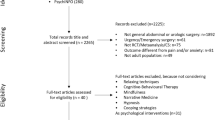Abstract
To test Janis' theory that preoperative worry can improve postoperative recovery, endocrine and subjective responses were measured in 27 patients undergoing major abdominal surgery which entailed threat to their health or longevity. Questionnaires to assess emotional and somatic state were completed preoperatively and for 7 days postoperatively. Plasma cortisol, noradrenaline, adrenaline, and glucose were measured pre-, per-, and postoperatively. Preoperatively, noradrenaline correlated positively with pain and distress, and adrenaline negatively. Postoperatively, endocrine levels and distress were not clearly related. Nevertheless, preoperative pain negatively correlated with postoperative adrenaline and cortisol levels. This, and the negative correlation between preoperative distress and postoperative pain are consistent with Janis' theory. In addition, we found that the longer patients waited on the day of surgery, the greater were the cortisol, noradrenaline, and glucose responses.
Similar content being viewed by others
References
Borkovec, T. D., Robinson, E., Pruzinsky, T., and DePree, J. A. (1983). Preliminary exploration of worry: Some characteristics and process.Behav. Res. Ther. 21: 9–16.
Brooks, J. E., Herbert, M., Walder, C. P., Selby, C., and Jeffcoate, W. J. (1986).Clin. Endocrinol. 24: 653–656.
Bursten, B., and Russ, J. J. (1965). Preoperative psychological state and corticosteroid levels of surgical patients.Psychosom. Med. 27: 309–316.
Child, C. S., and Kaufman, L. (1985). Effect of intrathecal diamorphine on the adrenocortical, hyperglycaemic and cardiovascular responses to major colonic surgery.Br. J. Anaesth. 57: 389–393.
Cox, T., and Cox, S. (1985). The role of the adrenals in the psychophysiology of stress. In Karas, E. (ed.),Current Issues in Clinical Psychology, Plenum, New York, Vol. 2.
Ellis, F. R., and Humphrey, D. E. (1982). Endocrine and metabolic changes relating to anaesthesia and surgery. In Watkins, J., and Salo, M. (eds.),Trauma, Stress and Immunity, Buterworth, London.
Feifel, H., Strack, S., and Nagy, V. T. (1987). Degree of life threat and differential use of coping modes.J. Psychosom. Res. 31: 91–99.
Fell, D., Derbyshire, D. R., Maile, C. J. D., Larsson, I.-M., Ellis, R., Achola, K. J., and Smith, G. (1985). Measurement of plasma catecholamine concentrations.Br. J. Anaesth. 57: 770–774.
Frankenaueser, M. (1980). Psychobiological aspects of life stress. In Levine, S., and Ursin, H. (eds.),Nato Conference on Coping and Health, Academic Press, New York.
Hall, G. M. (1985). The anaesthetic modification of the endocrine and metabolic response to surgery.Ann. Roy. Coll. Surg. Eng. 67: 25–29.
Ho, K. H., Hashish, I., Salmon, P., Freeman, R., Feinman, C., and Harvey, W. (1988). Reduction of post-operative swelling by a placebo effect.J. Psychosom. Med. 32: 197–205.
Hole, A. (1984). Per- and postoperative monocyte and lymphocyte functions: Effects of combined epidural and general anaesthesia.Acta Anaesthesiol. Scand. 28: 367–371.
Janis, I. L. (1958).Psychological Stress, Wiley, New York.
Johnston, M. (1978). Assessing recovery from surgery. Paper presented at the Annual Conference of the British Psychological Society, York, U.K.
Johnston, M. (1984). Dimensions of recovery from surgery.Int. Rev. Appl. Psychol. 33: 505–520.
Johnston, M., and Carpenter, L. (1980). Relationship between pre-operative anxiety and postoperative state.Psychol. Med. 10: 361–367.
Kaufman, L. (1981). The endocrine response to surgery and anaesthesia. In Scurr, C. A., and Feldman, S. (eds.),Scientific Foundations of Anaesthesia, Heinneman, London.
Kehlet, H. (1984). The stress response to anaesthesia and surgery: Release mechanisms and modifying factors.Clin. Anaesthesiol. 2: 315–339.
Mackay, C., Cox, T., Burrows, G., and Lazzerini, J. (1978). An inventory for the measurement of self-reported stress and arousal.Br. J. Soc. Clin. Psychol. 17, 283–284.
Main, C. (1983). The modified somatic perception questionnaire (MSPQ).J. Psychosom. Res. 27: 503–514.
Mullen, B., and Suls, J. (1982). The effectiveness of attention and rejection as coping styles: A meta-analysis of temporal differences.J. Psychosom. Res. 26: 43–49.
Nistrup Madsen, S., Fog-Moller, F., Christiansen, C., Vester-Andersen, T., and Engquist, A. (1978). Cyclic AMP, adrenaline and noradrenaline in plasma during surgery.Br. J. Surg. 65: 191.
Ray, C., and Fitzgibbon, G. (1981). Stress arousal and coping with surgery.Psychol. Med. 11: 741–746.
Rose, E. A., and King, T. C. (1978). Understanding post-operative fatigue.Surg. Gynecol. Obstet. 147: 97–101.
Salmon, P., Evans, R., and Humphrey, D. (1986). Anxiety and endocrine changes in surgical patients.Br. J. Clin. Psychol. 25: 135–141.
Smith, C. C. T., Curtis, L. D., Delamothe, A. P., Prichard, B. N. C., and Betteridge, D. J. (1985). The distribution of catecholamines between platelets and plasma in normal human subjects.Clin. Sci. 69: 1–6.
Spielberger, C. D., Gorsuch, R. K. L., and Lushene, R. E. (1970).Manual for the State-Trait Anxiety Inventory, Consulting Psychologists' Press, Palo Alto, Calif.
Wallace, L. M. (1986). Pre-operative state anxiety as a mediator of psychological adjustment to and recovery from surgery.Br. J. Med. Psychol. 59: 253–261.
Wells, J. K., Howard, G. S., Nowlin, W. F. N., and Vargas, M. J. (1986). Presurgical anxiety and postsurgical pain and adjustment: Effects of a stress inoculation procedure.J. Consult. Clin. Psychol. 54: 831–835.
Weitzman, E. D., Fukushima, D. K., Nogeire, C., Roffwarg, H., Gallagher, T. F., and Hellman, L. (1971). Twenty-four hour pattern of the episodic secretion of cortisol in normal subjects.J. Clin. Endocrinol. Metab. 33: 14–22.
Wilson, H. F. (1981). Behavioral preparation for surgery: Benefit or harm?J. Behav. Med. 4: 79–102.
Wolfer, J. A., and Davis, C. E. (1970). Assessment of surgical patients' pre-operative emotional condition and postoperative recovery.Nursing Res. 19: 407–414.
Author information
Authors and Affiliations
Rights and permissions
About this article
Cite this article
Salmon, P., Pearce, S., Smith, C.C.T. et al. The relationship of preoperative distress to endocrine and subjective responses to surgery: Support for Janis' theory. J Behav Med 11, 599–613 (1988). https://doi.org/10.1007/BF00844909
Accepted:
Issue Date:
DOI: https://doi.org/10.1007/BF00844909




